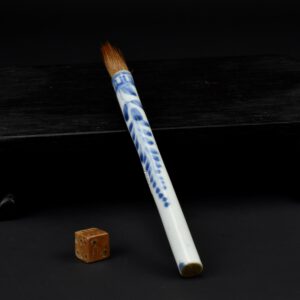
A Rare 17th Century Japanese Porcelain Dish of Kutani Type
A Rare 17th Century Japanese Porcelain Dish of Kutani Type, Arita Kilns c.1660-1680. This 17th Century Japanese saucer shaped dish employs an unusual technique, the design is moulded in bass-relief and then painted. The raised porcelain is almost imperceptible, it can clearly be felt, however it is difficult to see without the aid of a raking light. This highly unusual design depicts Washi paper, folded over to expose the paler underside, the paper has been laid over two brushes. Paper was introduced to Japan in the 7th century via the Korean Peninsula, Washi paper was used in Muromachi period (1336 – 1392) for ceremonial origami for the samurai class at weddings., it was then in popular use and is still produced by hand in Japan today. It is more robust that wood pulp paper, it was made of the inner fibres of the gami tree, the mitsumata shrub of the mulberry bush. For a Very Rare 17th Century Japanese Porcelain Brush from Robert McPherson Antiques stock number 25990, see below.
SOLD
- Condition
- There is a firing fault to the rim with an associated crack.
- Size
- Diameter : 18.2cm (7 1/4 inches). Depth 3 cm.
- Provenance
- N/A
- Stock number
- 27116
Information
Robert McPherson Antiques - 25990








